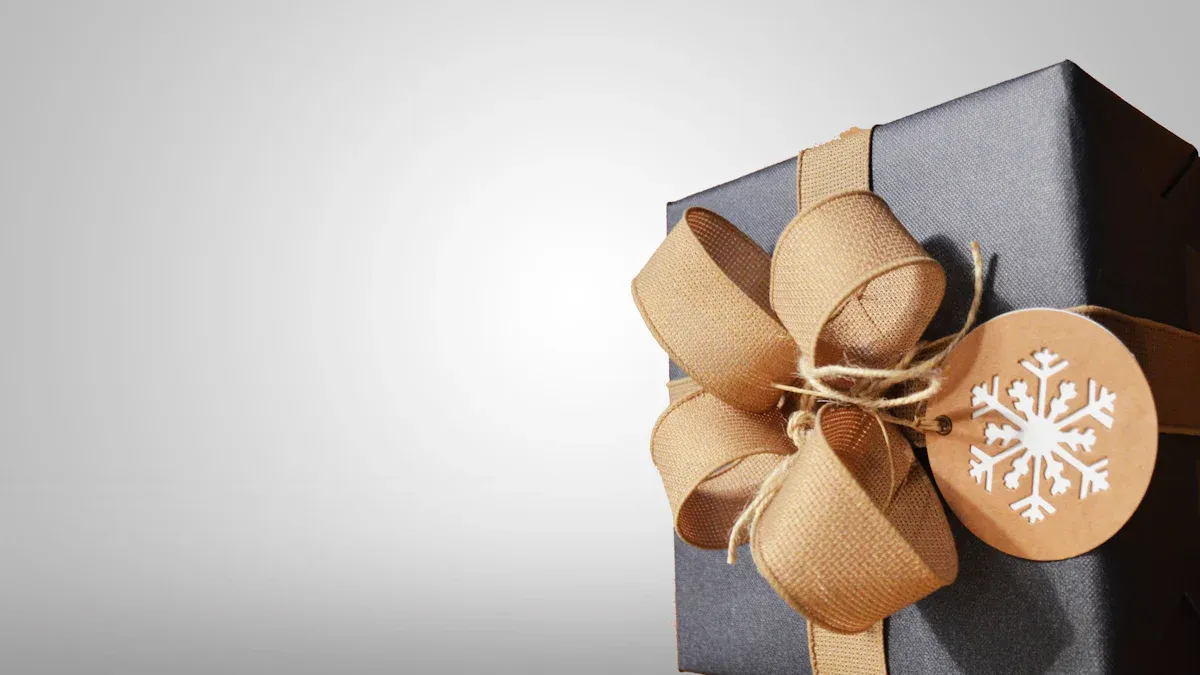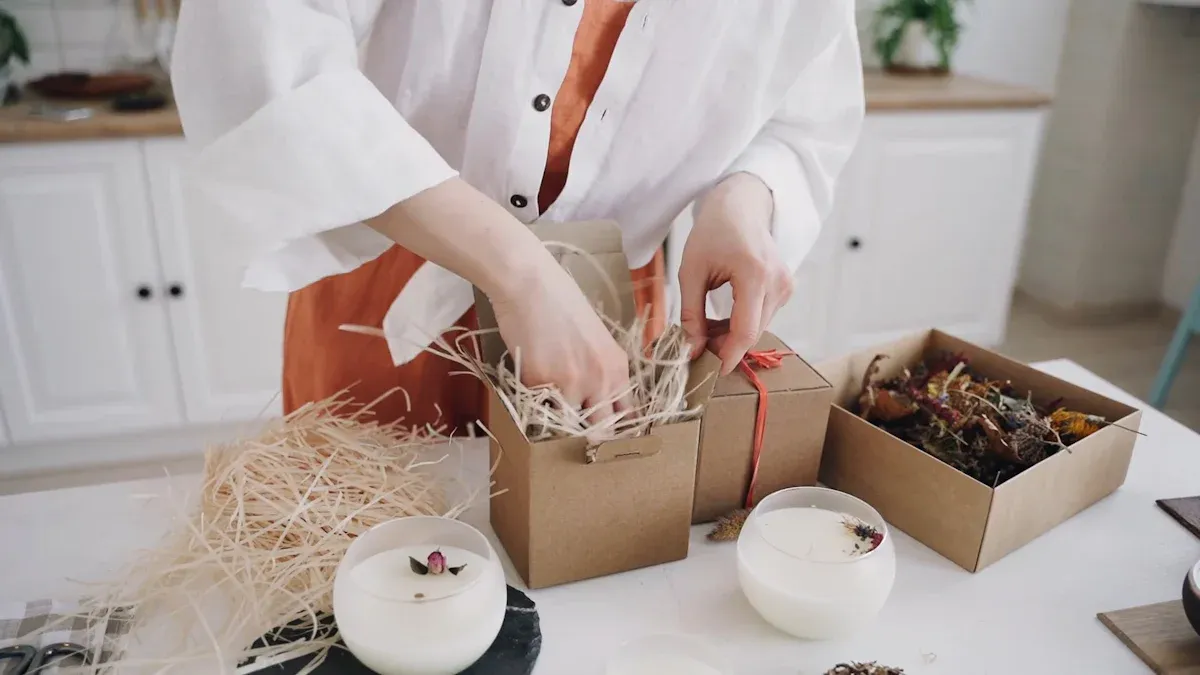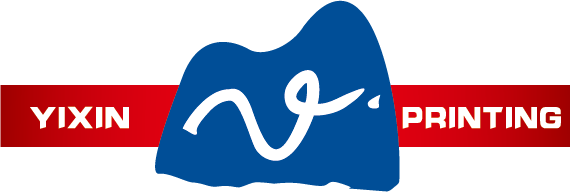
I believe quality control plays a vital role in crafting exceptional paper gift boxes. It ensures every box meets high standards, enhancing customer trust and satisfaction. As a paper gift box supplier, I prioritise durability and eco-friendly materials. Sustainable packaging solutions not only protect the environment but also align with modern consumer values.
Key Takeaways
Checking quality is key to making great paper gift boxes. It keeps customers happy and loyal to the brand.
Using green materials helps the planet and matches what buyers want. This makes the products more attractive.
Machines in factories work faster and better. They find mistakes early and keep the quality steady.
Why Quality Control Matters for Paper Gift Box Suppliers
The impact of quality on customer satisfaction and brand loyalty
I believe quality control plays a pivotal role in shaping customer satisfaction and loyalty. When customers receive high-quality custom paper boxes, they feel valued. This positive experience encourages them to return and recommend the brand to others. Packaging is often the first interaction a customer has with a product. It must reflect the brand's commitment to excellence.
The supplier's commitment to quality is crucial. Adhering to strict quality control measures ensures that the boxes protect products during transit, maintain their appearance, and create a positive impression on customers.
Additionally, I have noticed that incorporating customer feedback into the design of custom paper boxes strengthens trust. It shows that the brand listens and adapts to meet expectations. This approach not only enhances satisfaction but also fosters long-term loyalty.
High-quality luxury gift boxes enhance customer satisfaction by meeting and exceeding expectations.
Incorporating customer feedback into packaging design fosters brand loyalty.
Effective packaging communicates the brand's value and commitment to quality.
Meeting industry regulations and maintaining competitive advantage
Strict adherence to quality control measures ensures compliance with industry regulations. I always ensure that my manufacturing process meets these standards. This not only avoids legal complications but also positions my brand as a reliable paper gift box supplier. Customers prefer suppliers who consistently deliver quality while adhering to regulations. This builds trust and gives a competitive edge in the market.
Avoiding costly errors and product recalls
Neglecting quality control can lead to costly mistakes. Faulty packaging can damage products, resulting in returns or recalls. I have seen how recalls can tarnish a brand's reputation and lead to financial losses. For example, recalling 285,000 boxes of cereal could cost over $1.3 million. By implementing robust quality control measures, I minimise such risks and ensure smooth operations.
The number of food recalls in the U.S. has increased four-fold over the last five years.
The average direct cost of a recall for a food manufacturing company is approximately $10 million.
A specific example shows that recalling 285,000 boxes of cereal could lead to a minimum direct cost of $1,393,821, not including additional costs related to product destruction and investigation.
Quality control is not just about avoiding errors. It is about delivering excellence at every step of the custom paper box manufacturing process. This commitment ensures that my customers receive products they can trust.
Key Processes in Quality Control

Design phase: Balancing aesthetics and functionality
In the design phase, I focus on creating high-quality custom paper boxes that balance aesthetics and functionality. A visually appealing design attracts customers, but it must also serve its purpose effectively. For instance, transparent packaging combines durability with clarity, allowing consumers to see the product while protecting it. This visibility enhances the perceived quality of the product. However, I avoid prioritising beauty over usability, as this can lead to practical issues. Striking the right balance ensures the packaging meets both visual and functional expectations.
Material selection: Ensuring durability and eco-friendliness
Selecting the right materials is crucial in custom paper box manufacturing. I prioritise options like corrugated cardboard for its rigidity and impact resistance, or tissue paper for its lightweight, decorative qualities. Eco-friendliness is equally important. Many of the materials I use, such as kraft boxes and paperboard, are recyclable or biodegradable. This approach not only ensures durability but also aligns with sustainable practices, which modern consumers value highly.
Printing and finishing: Achieving precision and consistency
Printing and finishing require precision to maintain brand identity and customer trust. I use proofing procedures to catch errors before production begins. Colour management tools ensure the final product matches the design, while quality audits help identify trends in defects. These steps guarantee consistency and excellence in every batch. Effective communication between designers and printers further ensures that the final product meets expectations.
Assembly and structural integrity checks
During assembly, I ensure that every custom paper box meets structural integrity standards. Testing methods like environmental exposure simulation and weight capacity analysis validate the durability of the boxes. For example, I assess how well the packaging protects its contents under various conditions. These checks ensure that the boxes remain functional and visually appealing throughout their lifecycle.
Final inspections: Identifying and resolving defects
Final inspections and packaging are the last steps in the manufacturing process. I conduct thorough checks to identify and resolve any defects. Real-time monitoring tools help track metrics like defect rates and compliance with standards. These measures ensure that every box leaving my facility meets the highest quality control standards. By addressing issues at this stage, I deliver products that reflect my commitment to excellence.
Tracking metrics such as defect rates and compliance with standards ensures reliability and consistency in the final product.
Technology and Innovation in Quality Control
Automation for precision and efficiency in production
Automation has transformed the way I approach quality control in the manufacturing process. High-speed automated machinery equipped with sensors and cameras identifies defects like improper folding or glue application during production. This technology allows me to take immediate corrective actions, ensuring every custom paper box meets the highest standards. Real-time monitoring systems track production speed, material usage, and defect rates. These insights help me continuously improve processes and maintain excellence in quality control.
By implementing strict quality assurance protocols, I ensure that every box produced aligns with customer expectations. Automation not only enhances precision but also boosts efficiency, enabling me to deliver consistent results. This meticulous monitoring from raw material selection to final inspections and packaging significantly improves the overall quality control measures.
Digital printing advancements for superior results
Digital printing has revolutionised the way I customise paper gift boxes. Advanced technologies like Fiery® Command Workstation and Fiery XF 7 print servers have improved print production speed and quality. Wide-format inkjet printers offer market-leading efficiency and cost savings. These innovations allow me to provide quick turnaround times for small orders and on-demand printing services without maintaining large inventories.
The ability to customise designs with precision has attracted a broader customer base. Enhanced printing technology enables me to offer unique and personalised packaging solutions. This level of customisation strengthens customer satisfaction and reinforces my commitment to delivering excellence.
Real-time monitoring with quality testing tools
Real-time monitoring tools play a crucial role in maintaining quality control. I use fine-grained instrumentation and real-time alerts to detect errors during production. These tools enable me to troubleshoot issues quickly and resolve them before they affect customers. For example, statistical process control tests apply numerical criteria to ensure data accuracy throughout the manufacturing process.
Process observability reports, such as the Tornado Report, help me track errors and resolution times. This level of monitoring ensures that my custom paper boxes meet the highest standards. By integrating these tools into my inspections, I can deliver reliable and consistent results.
Overcoming Challenges in Quality Control
Addressing material inconsistencies and supplier issues
Material inconsistencies can disrupt the quality control process. I have encountered situations where suppliers delivered materials that did not meet the required standards. To address this, I conduct thorough inspections upon receiving materials. This ensures that only high-quality inputs are used in custom paper box manufacturing. Building strong relationships with reliable suppliers also helps minimise risks. I prefer working with partners who share my commitment to excellence and sustainability.
Regular communication with suppliers is essential. I provide clear specifications and expectations to avoid misunderstandings. When issues arise, I resolve them promptly to maintain production schedules. By taking these steps, I ensure that material inconsistencies do not compromise the quality of my products.
Minimising human errors in manual processes
Human errors can occur during manual processes, especially in tasks like assembly and inspection. To minimise these, I implement standardised procedures and provide comprehensive training for my team. Clear guidelines help workers understand their roles and responsibilities. I also encourage a culture of accountability, where team members take pride in their work.
Automation plays a significant role in reducing errors. For example, automated systems can detect defects during final inspections and packaging. This technology complements manual efforts, ensuring that every custom paper box meets the highest quality control standards. Combining human expertise with technological advancements creates a robust quality control framework.
Balancing cost-efficiency with high-quality standards
Balancing cost-efficiency with quality control measures is a challenge I face regularly. While sustainable materials may have a higher initial cost, they often lead to long-term savings. For instance, using recycled materials can provide tax incentives and attract eco-conscious customers. This approach not only reduces expenses but also enhances customer loyalty.
I also optimise packaging design to minimise material wastage. Customised package sizes reduce excess material use and lower shipping costs. These strategies allow me to maintain high-quality standards without compromising on cost-efficiency.
By adopting these practices, I achieve a balance between cost-efficiency and quality. This ensures that my products remain competitive while meeting customer expectations.
Sustainability in Quality Control Practices

Using recycled and biodegradable materials
I prioritise the use of recycled and biodegradable materials in custom paper box manufacturing. These materials not only reduce environmental impact but also align with modern consumer preferences for sustainable packaging. For instance, one ton of waste paper can produce 850 kilograms of recycled paper, saving 3 cubic metres of wood. This approach significantly reduces the need for virgin resources. Additionally, biodegradable packaging helps decrease landfill waste and lowers carbon emissions, contributing to a cleaner environment.
By integrating eco-friendly materials into my production process, I enhance the recyclability and reusability of high-quality custom paper boxes. This practice supports sustainability metrics, such as minimising material usage and exploring bio-based alternatives. I also ensure that all materials meet recyclability standards and are properly labelled for recycling. These efforts reflect my commitment to excellence and environmental responsibility.
Reducing waste through optimised production processes
Reducing waste is a key aspect of packaging quality control. I optimise production processes to minimise material wastage and improve efficiency. For example, customised package sizes reduce excess material use, while advanced machinery ensures precise cuts and folds. These measures not only lower production costs but also decrease the carbon footprint of each custom paper box.
Global waste statistics highlight the importance of waste reduction. Paper and cardboard packaging account for 17% of global waste, while plastic waste contributes 12%. By focusing on efficient production methods, I help reduce these figures. Additionally, optimised shipping practices, such as using lightweight materials, further minimise carbon emissions. Shipping a one-pound package over 500 miles emits 0.59 kilograms of carbon dioxide, so every improvement counts.
Adhering to certifications for sustainable packaging
Adhering to recognised certifications ensures that my packaging quality control practices meet global sustainability standards. Certifications like FSC validate responsible sourcing and forest management for paper-based products. BPI certification guarantees that compostable items meet strict compostability criteria. ISO 14001 certification demonstrates my commitment to continuous environmental improvement through an effective management system.
These certifications not only enhance the credibility of my products but also reassure customers about their sustainability. By meeting these standards, I strengthen my position as a reliable paper gift box supplier. This adherence to certifications reflects my dedication to delivering excellence in every aspect of custom paper box manufacturing.
Quality control remains the cornerstone of paper gift box manufacturing. It ensures products meet high quality standards, fostering customer satisfaction and loyalty. By embracing technology, innovation, and sustainability, I focus on achieving excellence in every step of production. Businesses should always prioritise quality when choosing a supplier to ensure superior results and long-term success.
FAQ
What makes quality control essential in paper gift box manufacturing?
Quality control ensures that every box meets high standards. It prevents defects, enhances customer satisfaction, and builds trust. This process also helps maintain brand reputation and loyalty.
How do paper gift box suppliers ensure sustainability?
I use recycled and biodegradable materials. I optimise production to reduce waste and adhere to certifications like FSC and ISO 14001. These practices minimise environmental impact.
Can automation improve quality control in packaging?
Yes, automation enhances precision and efficiency. Advanced machinery detects defects during production. Real-time monitoring tools ensure consistent quality, reducing errors and improving overall manufacturing processes.

